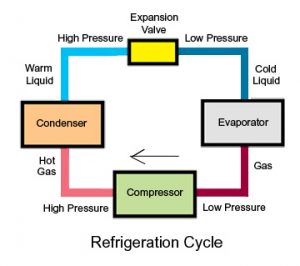Function.
An air-conditioner fills two functions: Cooling and dehumidifying the air.
Implementation.
The air conditioner fills these functions using a number of components, interconnected by pipes in a closed loop. Within the pipes circulates the refrigerant which is then processed by the compressor, condenser, expansion valve, and evaporator in, what is called, the refrigeration cycle.,
The Refrigeration Cycle.
The details of the refrigeration cycle are shown in the functional representation at the bottom of this blog. The condenser and evaporator provide the transitions between the liquid and gaseous refrigerant segments. The compressor and expansion valve provide the transitions between the high and low-pressure segments.
Air Cooling.
Cooling occurs at the evaporator in which the cold liquid refrigerant is converted into a gas. This process requires heat from the surrounding warm, moist air and therefore cools it.
Dehumidifier Action.
Humidity is removed by the condenser in which the gas refrigerant is converted into a liquid. This process releases heat to the surrounding air. When the humid hot air comes in contact with the cold surface of the condenser, condensation takes place. The water vapor turns into water droplets which are collected and removed from the air conditioner through a pipe.
Condensers and Evaporators.
They are physically identical coil structures made out of either copper or aluminum.
Compressor.
The function of the Compressor is to circulate the refrigerant. and raise the pressure and temperature of the gas before entering the Condenser.
Expansion Valve.
The Expansion Valve lowers the temperature of the liquid refrigerant entering the Evaporator.
The Refrigerants.
For maximum performance, the refrigerant liquid should be as cold as possible, which means a low BP (Boiling point). Another consideration is low GWP (Global warming potential). Currently used refrigerants are HFCs (hydrofluorocarbons) R-32 and R-410A. Their specs are
HFC BP (C) GWP
R-32 – 52 675
R-410A – 48.5 2088
Heat Pump
A heat pump functions as either a cooling or heating device. One way of switching from cooling to heating is to reverse the flow of the refrigerant. The functions of the condenser and evaporator will then be interchanged. The evaporator becomes a condenser, heating instead of cooling the air.

